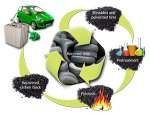The boffins at Oak Ridge National Laboratories (ORNL) have found a way to put old tyres to good use – as anodes in lithium-ion batteries.
Approximately 300 million tires are scrapped or dumped annually in the USA alone and around 25% wind up in landfills. Of the tyres reclaimed in the USA, almost half are burned as “Tire Derived Fuel” (TDF); alongside other polluting fuels such as coal.
There’s a popular misconception that today’s tires are made from rubber. More than 90% are made from synthetic materials; some of which are carcinogenic. When fires break out in piles of discarded tyres, they can be very difficult to put out and the burning spews toxic black, oily smoke into the atmosphere.
An ORNL team led by Parans Paranthaman and Amit Naskar is developing a better anode for lithium-ion batteries, using the carbon black from reclaimed tyres. The technique used involves a proprietary pretreatment to recover pyrolytic carbon black material. The researchers have produced a small, laboratory-scale battery demonstrating a reversible capacity that is higher than what is possible with commercially available graphite materials.
“Using waste tires for products such as energy storage is very attractive not only from the carbon materials recovery perspective but also for controlling environmental hazards caused by waste tire stock piles,” said Parans Paranthaman.
Amit Naskar says their team’s development is an “inexpensive, environmentally benign carbon composite anode material with high-surface area, higher-rate capability and long-term stability”.
ORNL states it plans to work with U.S. industry to license the technology and produce lithium-ion cells for transport and general energy storage applications. The materials market for lithium-ion batteries is expected to hit $11 billion in 2018
Oak Ridge National Laboratory is the USA Department of Energy’s largest multiprogram science and energy laboratory.
Earlier this week we reported on another type of toxic trash that can be used in the production of coatings for lithium-ion battery anodes – cigarette butts.
Source













































